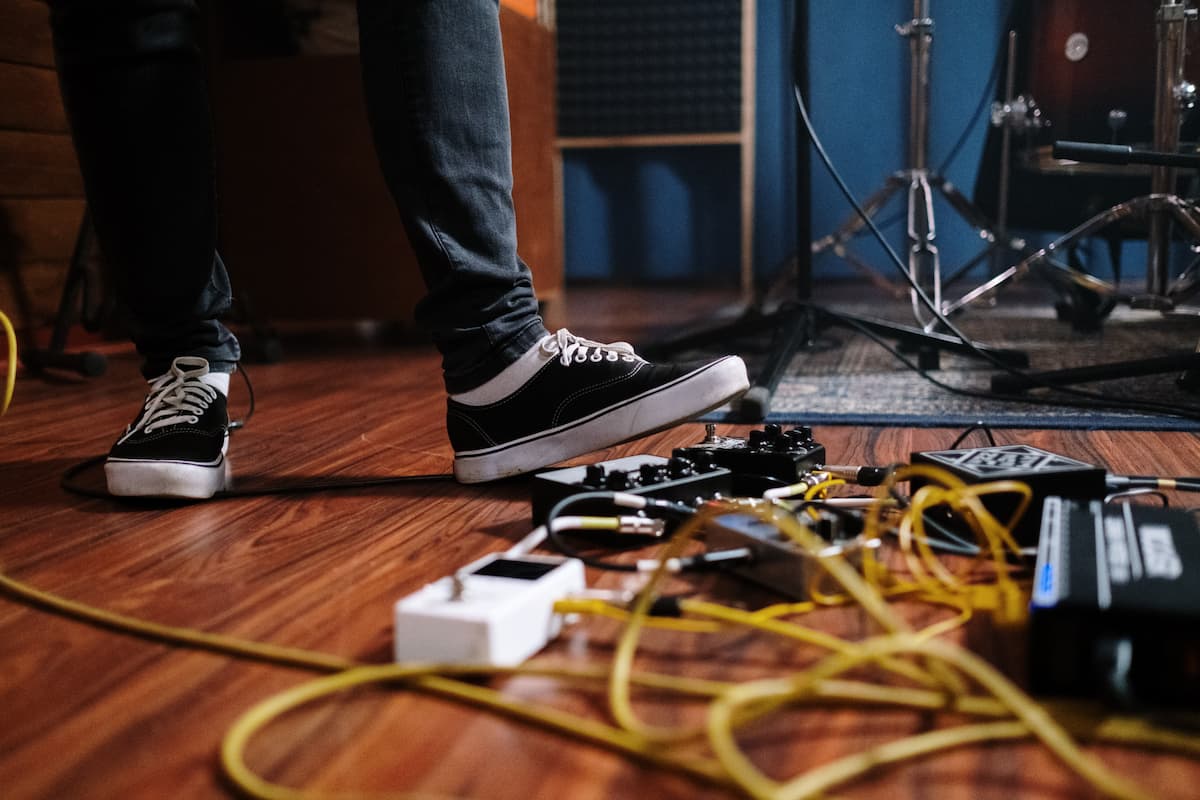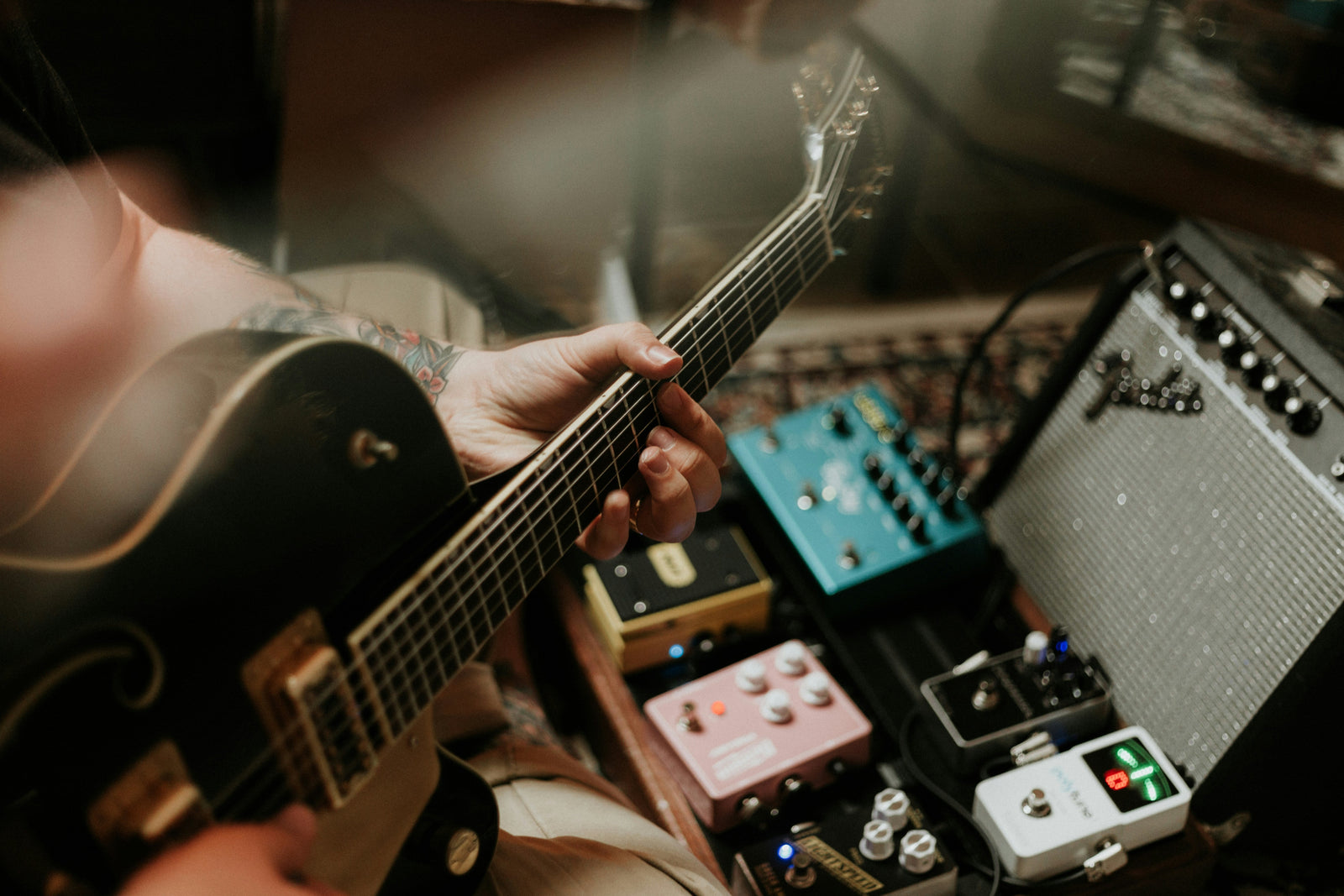BOSS Guitar Pedals: Pitch/Modulation
Enhance your guitar tone with BOSS, a leader in effects pedals. BOSS, with over 30 years of industry expertise. It offers a range of practice pedals featuring overdrive, distortion, and delay effects.
Beyond these basics, BOSS provides a diverse selection. Including pitch shift and modulation pedals. Experiment with different sounds, from synth-like tones to gritty textures for lead work.
Whether you're a seasoned musician or a beginner building your first guitar setup. Explore the versatility of BOSS Guitar Pedals Pitch/Modulation.
What are BOSS Guitar Pedals Pitch?
Pitch shifter pedals tweak guitar pitch for unique harmonies and effects. Mixing with dry signals creates interesting harmonies.
Despite the name, they're versatile across instruments, offering surprising effects. They expand sonic possibilities for guitarists and bassists alike. Pitch shifters emulate synth and keyboard sounds, broadening guitar tonality.
These pedals add depth and complexity to musical arrangements. They're not for guitars; they work with various instruments.
With pitch shifting, musicians explore new creative avenues. These pedals enhance expressiveness and creativity in performances.
Experiment with harmonics and emulate entire bands' sounds. Pitch shifters offer fun and versatility for musicians to explore. They're essential tools for expanding musical horizons.
Why You Should Get A BOSS Guitar Pedals Pitch?
Do you love playing guitar or bass? Ever tried recreating Eddie Van Halen, David Bowie, or Joe Satriani's wailing vocals? Then you've spent some time using pitch-shifting effects! Pitch-shifting effects create harmonies and often mimic the sounds of singers.
Apply them to guitar or bass pedals for stacked pitch-shifting bands. Let's take a look at how pitch-shifting effects work.
How Does BOSS Guitar Pedal Pitch Work?
Alter your guitar's pitch with a real-time BOSS guitar pedal Pitch. These pedals change tones by adjusting frequencies and note values. It is not shifting input tone direction alone. The goal is to match the melody for each note played.
This flexibility helps find the perfect key. It is crucial for playing with a band or adjusting to vocal performances during shows. Small adjustments with pitch-shifting pedals can yield impactful changes in your music. These pedals offer a versatile solution for musicians seeking precision. Also, to the adaptability in their performances.
Kind of BOSS Guitar Pedal Pitch?
There are two ways you can pitch shift an audio signal. These methods fall under two branches: polyphonic and monophonic. It may be confusing how there is a distinction between these two terms. Especially since they both apply to pitch shifting.
Here’s what you should know:
Monophonic
Monophonic shifters adjust pitch one semitone at a time. It is ideal for sustained sounds like vocals and electric guitar. Many DIY boxes are monophonic for simplicity and pleasing sounds. For true harmony and chords, opt for a polyphonic pedal.
Polyphonic
Polyphonic processors analyze many voices at once, handling up to 6 notes. This capability offers extensive opportunities for unique effects. Polyphonic processors analyze many voices at once, handling up to 6 notes. Ideal for creating harmonies or transforming a bass guitar into a cello.
Consider polyphonic pedals as tools for processing chords and progressions. It is valuable in bands with diverse keys or modulations.
Understanding these distinctions ensures you choose the right pitch-shifting pedal.
What Are The Types of BOSS Guitar Pedals Pitch?
Here is a quick overview of the types of pitch-shift guitar pedals you might encounter.
1. Octave Guitar Pedals:
The classic octave pedal adds octaves above and below your input signal. Placed before your amp, it acts as a bass line; after, a lead guitar line. Many octaves create a unique sound, reminiscent of an organ.
Octave pedals can transform your melody by adding a synth-like layer. When used effectively, two octaves can emulate a second bass line.
2. Harmonizer Guitar Pedals:
Harmonizers shift pitch, adding a perfect fifth above and below the original. They produce musical harmony, turning simple chords into rich, beautiful sounds. Ideal for creating intricate harmonies or enhancing melody lines.
3. Transposition-Style Guitar Pedals:
Transposition pedals shift the pitch of the entire instrument up or down. Replace the need for a capo by adjusting the pitch range. Ensure proper tuning before performing to avoid unexpected variations.
4. Pitch-Bending Guitar Pedals:
Pitch-bending is time-based, offering a unique approach to pitch shifting. Controlled by a continuous gear system, allowing speed adjustments and reversals.
Explore various modes and parameter groups for a vibrant and character-rich sound. Mimic real-life effects like Vibrato, create a dynamic and expressive performance. The continuous system of gears ensures a constant rate for a seamless pitch bend.
Listen as Johnny DeMarco shows us that a pitch shifter guitar pedal can do wonders for our guitars.
BOSS Guitar Pedals: Pitch Shifter
TOP BOSS Pitch Guitar Pedal: PS-6 Harmonist
Introducing the BOSS PS-6 Harmonist. A powerhouse unit with four pitch-shift effects and three-voice harmony. Among its features:
- Choose from Harmony, Pitch Shifter, Detune, and the new Super Bend.
- Create wild pitch sweeps and authentic pedal-bending effects.
- Control pitch with an optional expression pedal for added versatility.
The PS-6 Harmonist excels in generating two or three voices. In Pitch Shifter, Detune, and Harmony modes adding rich depth to your guitar sound. Detune provides a natural sound with 3-voice detuning. Additionally, voices can be pitch-shifted for arpeggio-style playing.
Manipulate a variety of effects. In Harmony mode, select the key, choose major or minor, and use the SHIFT knob to pick your voicing. The Shift knob switches between different pitch settings in each mode.
The PS-6 Harmonist delivers superior sound quality. Also, easy to use and has powerful pitch effects in one unit.
What Are BOSS Guitar Pedals Modulation?
Modulation pedals transform guitar characteristics, changing with rate and depth parameters. Rate controls speed, and depth controls intensity. Tremolo modulates the guitar's volume, adding dynamic effects to your sound.
Chorus, flanging, tremolo, and phasing are modulation effects. It enhances your guitar's motion and depth. Also, modulation pedals offer versatile ways to inject unique flavors into your rig. Distortion, overdrive, and fuzz alter signals, but modulation adds interesting, unique sounds.
In guitar effects, modulation adds more layers to your signal path. Creating distinct tones. The process occurs in the waveform within the cabinet or amplifier circuits. Offering sounds unattainable otherwise. Modulation, beyond vibrating strings, delivers a diverse sonic palette to your music.
Why You Should Get A BOSS Guitar Pedals Modulation?
Modulation in guitar pedals refers to varying the output volume of your instrument. It's used to create complex sounds without relying on distortion. Achieving this effect involves electronic alterations, changing the perception of the guitar's volume.
Modulation pedals add depth and movement to your guitar tone. They're great for expanding the tonal palette of your guitar. Each pedal offers specific functions, contributing to a unique sound. With these pedals, you control how the effect modifies your tone.
Modulation pedals invite experimentation and sonic exploration. They're a key tool for guitarists looking to discover new sounds. Whether for subtle color or dramatic effect, modulation pedals offer diverse possibilities. Their use can transform an ordinary guitar line into something extraordinary.
What Are The Types of BOSS Guitar Pedals Modulation?
There are several different types of modulation and every pedal will have high-level controls for it.
1. Flanger
The flanger pedal adds a slight delay to the signal, creating a modulation effect. It produces a sound akin to many guitars playing.
Using a flanger can give a lead guitar a distinctive sound with fading high frequencies.
2. Chorus
Chorus pedals are popular for thickening your guitar's sound.
They create the illusion of many instruments playing the same line. When combined with other effects like reverb, they produce a rich, textured sound.
3. Phaser
A phaser splits your guitar signal into two paths, one original and one delayed. As you adjust the phaser, it changes the mix of these signals, adding depth to your tone.
It's more selective in its filtering compared to a flanger.
4. Tremolo
Tremolo creates a rhythmic pulsing effect, enhancing the dynamism of your sound. It works by attenuating and boosting the signal in cycles.
Tremolo is distinct from vibrato, as it varies in volume, not pitch.
If you’re confused about how these different types of modulations sound, let’s watch how Rabea Massaad demonstrates one of the famous BOSS Guitar Pedals: MD-200 Modulation.
BOSS Guitar Pedals: Modulation
- BF-3 Flanger
- CE-2W Chorus
- CE-5 Chorus Ensemble
- CH-1 Super Chorus
- DC-2W Dimension C
- MD-200 Modulation
- MD-500 Modulation
- PH-3 Phase Shifter
- TR-2 Tremolo
- VB-2W Vibrato
TOP BOSS Modulation Guitar Pedal:PH-3 Phase Shifter
The BOSS PH-3 Phase Shifter is a treasure trove of phasing effects. It offers both classic vibes and innovative sounds. New "Rise" and "Fall" modes in the PH-3 provide unique directional phasing.
Syncing its effects is easy – tap the pedal to your desired tempo. For hands-on control, an optional expression pedal adjusts the Rate and Filter. This level of control enhances your live performance dynamics.
The PH-3's versatility extends to different phasing styles:
- "Rise" and "Fall" modes for unidirectional phasing effects.
- Options for 4-, 8-, 10-, and 12-stage phasers.
- A Step effect for varied phasing rhythms.
The PH-3’s Infinite Phaser creates ascending or descending tones. It's perfect for crafting distinct soundscapes.
Using the PH-3, guitarists can explore a wide spectrum of tonal possibilities. It's ideal for adding movement and depth to your guitar's sound. Whether you're playing rhythm or lead, the PH-3 adds a unique flavor.
The pedal's intuitive design ensures ease of use, even for beginners. Experimenting with its settings can lead to discovering your signature sound. The PH-3 Phase Shifter stands out as a top choice for modulation effects. Essential for guitarists to expand their sonic range.
BOSS Guitar Pedals Pitch And Modulation: What Are The Differences And Similarities?
Modulation and pitch-shifting effects, while distinct, share some common ground. Both effects change your guitar's sound, sometimes in unexpected ways. Understanding differences and similarities helps when selecting the right effect for your music.
Pitch-shifting alters the pitch of your guitar notes, creating harmonies or changing keys. Modulation effects, yet, manipulate the sound to create vibrato, chorus, or flange effects. Both types of pedals can add extra notes or alter the existing tone.
- Pitch-shifting changes the pitch of your guitar's notes.
- Modulation effects add depth and texture to the original sound.
- Both can create harmonics and new overtones.
While they use similar technology, their applications differ. Pitch-shifting is great for experimental sounds or harmonizing. Modulation is ideal for adding richness and movement to your tone.
Both effects offer creative ways to enhance your guitar playing. They open up a world of sonic possibilities, from subtle to dramatic changes. Whether you're playing live or recording, these effects can impact your sound.
Understanding the nuances of each effect is key to effective use. Experimenting with both can lead to unique and personal guitar tones.
BOSS Guitar Pedals Pitch And Modulation: Conclusion
Using BOSS guitar pedals pitch or modulation changes your guitar's sound. These pedals enable a wide array of sounds, each with distinct qualities. Preferences vary; some enjoy trippy phaser effects. But, others might find them too mechanical.
Understanding each pedal's sound is key before integrating it into your style.
It's important to know the unique effects of each pedal. Familiarity with their sounds ensures they match your musical expression. These pedals invite exploration and creativity in your playing.
Thoughtful use is essential for achieving the desired effect. BOSS guitar pedals pitch and modulation expand your musical possibilities.





